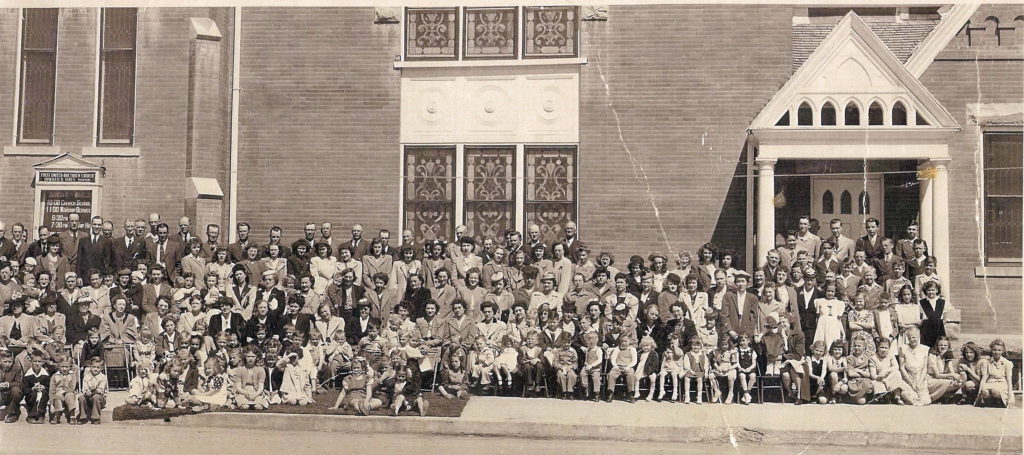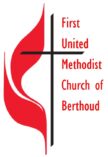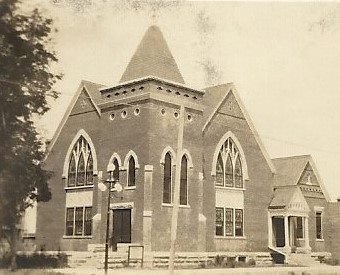Building The Second Church - 1887
After the town was relocated to its present-day site, the town founder’s wife Elizabeth “Aunt Betty” Turner donated lots for a church at 4th Street and Turner Avenue. In 1886 Reverend A.E. Seibert was assigned to Berthoud with the charge of raising money to build a church. The conference provided the fledgling congregation with $100 “to further this work.” In a short time during Seibert’s pastorate, church membership grew from 3 to 68. Berthoud’s first United Brethren Church building was constructed on the northeast corner of 4th and Turner in the fall of 1886 and dedicated in January 1887. At the time of its construction, the building did not have a bell tower or steeple, both of which were added in 1893. (That building still stands, minus the bell tower and steeple, and today functions as a home.)
In 1887 the conference assigned Reverend George Wood to serve the Berthoud church exclusively. He was the first pastor who did not have to share his time with Mt. Zion.


In 1889 the congregation purchased its first parsonage at 542 Welch Avenue; Reverend Wood was its first occupant. In order to be located closer to the church, _the congregation later built a parsonage across the street diagonally from the church. This new parsonage cost $1200 to build, and Reverend A.H. Hooker was the first pastor to live there. The parsonage had such modern conveniences as a sewer connection and running water,
When Mrs. Turner died in 1902, her funeral was held at the church whose land she had donated with more than 500 people attending; this was obviously an overflow crowd for a sanctuary that could hold no more than 100 people. Following the service, more than 100 buggies fell into line behind the horse-drawn hearse to escort the town founder’s wife to her final resting place in Greenlawn Cemetery.

Building the Third Church - 1904
By 1903 the church’s membership had grown to the extent that the church was too small. In 1904, with the congregation having outgrown the building, a Fort Collins contractor John A. Bell was hired to build a new church at the northeast corner of 4th Street and Mountain Avenue at a cost of $10,000. The new building was dedicated in June 1905. The building committee included many men whose families continued to play important roles in that church for decades as well as in our church today-J.M. Lutener, O.J. Smith, WE. Edmondson, L.P. Milburn, F.P. Haworth,A.G. Bimson,J.B. Clymer, George W. Kee, H.K. Hankins, Quincy Williamson, James Jensen, and W.H. McCormick, the itinerant preacher who served at Little Thompson and chaired the committee.
Since the United Brethren placed an emphasis on Sunday school, the building was designed according to the “Akron Plan,” which featured a series of classrooms that opened to or adjoined the sanctuary; in the church at 4th and Mountain, large sliding doors divided the sanctuary from the largest · classroom. The Akron Plan allowed each class to open a classroom wall or step out of the classroom to view the sanctuary and participate in the opening ceremonies for Sunday school. Following the opening exercises, class members closed the sliding doors or returned to their classrooms. Since the United Brethren believed in full-immersion baptism, the altar area contained a baptismal tank beneath a trap door where baptisms were performed.
In the early years, it wasn’t uncommon for 200 people to attend Sunday school on a given Sunday. Due to this large number, the congregation felt the need for more Sunday school rooms so the men of the church were enlisted to enlarge a small basement room. The men met at night with picks and shovels. With no other way to dispose of the dirt, they threw it out the basement windows. In short order the hole was large enough to accommodate several new Sunday school rooms in the basement.
Like the first church the United Brethren built in Berthoud in 1886, the second church erected at Fourth Street and Mountain Avenue in 1904 eventually proved too small. In the early 1950s, a few years after the United Brethren merged with the Evangelical church, it became evident to the congregation that the old church needed to be repaired and enlarged or possibly replaced.
In 1952 under the guidance Bishop Ira D. Warner and church pastor Howard Hines, a plan was approved by the Berthoud congregation for “the matter of raising money by pledge looking forward to raising a substantial amount for a building program.” One year later in 1953, new pastor Rev. O.L. Grauberger obtained cost estimates for the redecoration of the sanctuary and the erection of a new “Sunday school unit” on the existing church grounds.
Second Merger and Name Change
In 1946, after 20 years of negotiations, the church received a new name when the United Brethren merged with the Evangelical Church to become the Evangelical United Brethren Church.


